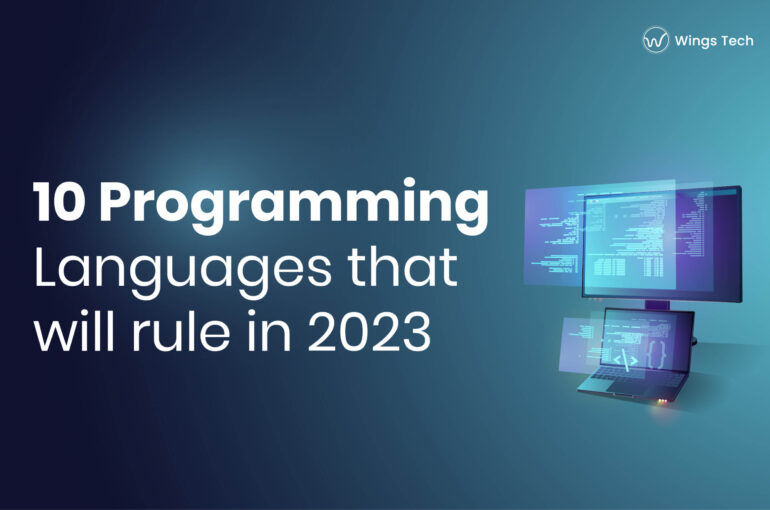10 Programming Languages that will rule in 2023

Even though we humans are community-based creatures and can take the help of others to carry out tasks to get results, there is always an exponential scope for delegating more tasks to more people and reliance on external entities such as weapons, tools, shelter, etc. The more evolved we became, the more our needs and cognitive overload increased. So, over the years, the technological revolution made our lives easier as we could delegate mundane and laborious tasks to machines.
The technological revolution involves the revolution of just about every kind of technology that we use today including computers.
Before getting to the topic of programming languages that are predicted to rule in the year 2023, we will talk about the evolution of computer technology and the need for a wide variety of technical tools to solve multiple problems.
Back in the day in the 1970s, computers were nothing but glorified calculators. Fast forwarding to now, computers are now our virtual superheroes. We can materialize just about any idea that comes to our minds. We are now so reliant on computers and technology that we find ourselves handicapped without them. They have now become our extended body parts.
Ever since Binary code in 1689 to the very first computer in 1883 to the Metaverse in the 2020s, humanity has been on a journey of constant change with respect to interacting with technology. Instructing computers to carry out a huge variety of tasks has now become easier than ever. When the assembly languages like Cobol and Fortran were pioneered in the late 1950s, they made computer scientists’ lives a lot easier. Today, programming languages like JavaScript and Python are ruling the world of computer science.
Even though technology has reached where it is today, we cannot say or predict that it has reached its peak. There is always room for improvement, solving problems quicker and more efficiently than we did the previous day. Every person in the world is trying to solve a variety of problems better than before including the betterment and enhancement of technology.
We all know we instruct and interact with computers using different programming languages but you must be wondering why there are so many programming languages in existence. The reason is that they are tools and we need different kinds of tools to solve different kinds of problems.
As an analogy, we will take an example of a tree and an apple. To cut a tree, would you use an axe or a knife? An axe, of course. You would not use a knife to cut a tree because it is not capable enough to get the job done. Whereas, to cut an apple we will have to use a knife and not an axe because using an axe would be a waste of resources which is not efficient.
Likewise, from a technical perspective, we will take an example of two programming languages, JavaScript and C++. JavaScript is used for Front-end development where execution and speed are paramount but programmers do not prefer to use it in the back end because it is not capable enough to handle the security issues that arise due to its loosely-typed nature. Whereas C++ is not suitable for the front end because of its verbose nature which will affect the speed and performance of a website but it works very efficiently in the back end and operating system-related tasks since it is a tightly typed language and will prevent security issues.
Going one step further, To solve problems in a better way, we need better tools and frameworks. This means we need to change and update our toolset consistently. This is why there are multiple programming languages with so many updates almost every year. This means that programmers may need to step up their game by learning new programming languages to keep themselves up to date to tackle new sets of problems that they might encounter in the future.
With that in mind, let’s take a look at the top 10 programming languages that will emerge victorious in 2023:
Python
The undisputed champion of programming languages has no plans for stepping down anytime soon. Python has been the most popular programming language since mid-2015 and is still gaining more popularity with each passing year. The two main reasons behind its popularity are ease of learning and the support of its extended libraries and modules. Data scientists and machine learning experts rely on Python because their primary expertise is not programming but working with big data. Since Python is easy to learn and has huge libraries and modules to support multiple tasks, they prefer it over other programming languages. Python also has a wide range of usability ranging from the Internet of Things (IoT) to web development. This makes it the most versatile programming language to date.
Rust
Rust was developed by Mozilla Firefox in 2010. It is a general-purpose programming language with the capability to run on multiple paradigms. It is most suitable for systems programming but it also offers high-level features. Rust enforces memory safety, which means all references point to valid memory without the need for a garbage collector that exists in languages like C++ and Java. In 2020 when companies like DropBox, Firefox, and Cloudflare needed to find a solution for code safety they opted for Rust as an operational replacement for C++. The compiler of Rust helps in processing heavy data loads. This is one of the reasons why companies like Meta, Microsoft, Amazon, etc. are dependent on Rust for server operations.
GoLang
GoLang is a statistically typed language developed by Google in 2009. Statistically typed means that the variables are known at compile time. This is a multi-paradigm, concurrent imperative, and object-oriented programming language. GoLang offers memory safety as well along with features like garbage collection and structural typing. The syntax of GoLang is similar to C language. Notably, GoLang has readability and usability like Python and JavaScript. It also offers features that aid high-performance networking and multiprocessing. It is said that GoLang seems to be a viable substitute for high-performance languages like Java. Companies like Twitch, Uber, Google, Dropbox, etc. have adopted GoLang in their operations of cloud computing, server-side computing, and DevOps.
Kotlin
Kotlin was first developed in 2011 by JetBrains. It is designed to be a multi-paradigm, object-oriented, functional imperative language. It is an open-source, expressive language that is designed to be type and null-safe. It is meant to operate alongside Java for Android development. Interestingly, Java can do everything that Kotlin can do but Kotlin makes the tasks easier to complete. The flagship product of JetBrains, IntelliJ IDE is developed using Kotlin. It is gaining more popularity because of its concise nature and the fact that it is easy to read and maintain as compared to Java.
TypeScript
TypeScript was developed in 2012 by Microsoft. Many people confuse TypeScript with JavaScript. TypeScript is a syntactical superset of JavaScript, which means, it shares similarities with JavaScript with respect to features but the tightness of the syntax is increased compared to JavaScript. Programmers coming from an object-oriented background should find it easy to learn TypeScript. It is required to learn the basics of JavaScript first to understand the concepts of TypeScript. With the help of TypeScript, we can make powerful web applications with ease.
C/C++
Dennis Riche developed the C language in 1970. Later, Bjarne Stroustrup designed C++ in 1983 as an enhancement over C language. Considered to be one of the very first few high-level languages, C and C++ have been around for the longest amount of time. These languages have helped in developing compilers, new programming languages, and Microsoft Windows naming a few. Python, being the most popular language is also developed in C language. The dynamic memory allocation of C++ helps in faster execution. Many companies around the world rely on C/C++ to carry out server-side and operating system-related tasks.
Java
Java was first released back in 1996 by Oracle. It is considered to be one of the most robust languages for developing the back end of applications due to its enhanced security features. It is a high-level, class-based, object-oriented programming language. It has one of the biggest communities, the most number of repositories, and strong support from programmers all around the world. Java is used in a variety of paradigms such as operating systems, enterprise applications, big data, mobile applications, etc. It Is not going out of fashion anytime soon.
JavaScript
JavaScript was developed by Brendan Eich in 1995. One of the most versatile programming languages, JavaScript is not at all behind with respect to its usability. It is considered to be the king in the domain of web development. It is simpler to learn compared to other languages since it is a loosely-typed language. JavaScript makes complex integrations easier, increasing the speed and efficiency of web applications. This language also has huge online community support with a lot of users across the globe.
Swift
Swift is an open-source general-purpose, multi-paradigm programming language developed by Apple in 2014. Swift was intended to be the replacement for Objective-C since. Developers preferred the simplicity and conciseness of Swift over the verbose nature of Objective-C. Despite this fact, both these languages are widely used in iOS application development. Swift is considered to be similar to C language in many ways, i.e. mostly with respect to its syntax.
C#
C# was developed by Microsoft in the year 2000. It is also a high-level and multi-paradigm programming language with object-oriented features. C# is used for various purposes such as game development, mobile app development, web application development, cloud services, enterprise software, etc. Initially, it was named COOL, i.e. “C-like Object Oriented Language“ but Microsoft had issues with the trademark law so it renamed it to C#. It requires a Windows .NET framework to function appropriately. The language is also used widely for developing Windows desktop applications. C# integrates with the famous game engine Unity seamlessly and because of this, it can be used on any mobile platform with the help of cross-platform technology like Xamarin.
Reading this might help you make an informed decision as to which new programming language you should learn in 2023. Comment your favorite one. Ciao!

















